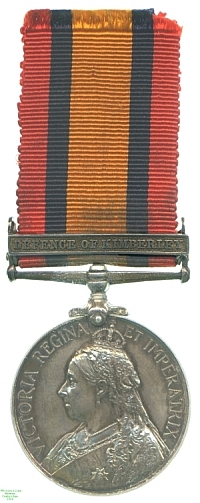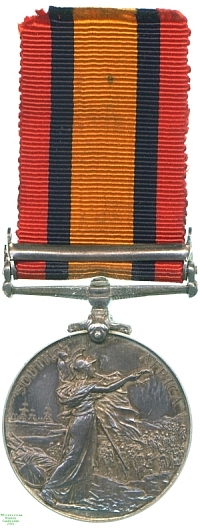
Obverse, a bust of Queen Victoria with veil

Reverse, Britannia in the foreground facing right holding a standard and waving a wreath over an army marching along the shore, with ships offshore in the background

Obverse, a bust of Queen Victoria with veil |

Reverse, Britannia in the foreground facing right holding a standard and waving a wreath over an army marching along the shore, with ships offshore in the background |
During the 1830s and 1840s several Dutch republics had been established outside the British Cape Colony in South Africa, among which were Transvaal and the Orange Free State, all now in modern South Africa. Transvaal was annexed briefly by the British but its independence re-established in the First Boer War.
In the 1880s however the discovery of vast gold reserves in Transvaal brought large numbers of foreign settlers, largely British, across the border, and an attempted coup at the instigation of Cecil Rhodes in 1895. Military escalation followed, negotiations failed and the two Boer republics, convinced that the British intended annexation, declared war on the Cape Colony in October 1899.
The immediate result was the siege of British troops in Ladysmith, Mafeking and Kimberley, while field forces attempting to come to their relief were defeated in several open battles by Boer contingents. Kimberley, the first town to be relieved, could open its gates only in mid-February; Mafeking, famously, had to hold out until May. By now Boer resistance in the field was more or less defeated but their forces maintained a bitter and obdurate guerilla campaign in several areas of the two Republics until mid-1902, when a surrender was finally agreed.
This medal is inscribed to Private E. Jennings of the Liverpool Regiment. The Regiment's Medal Rolls however appear to indicate that Jennings's 3rd Battalion did not arrive in South Africa until after Kimberley had been relieved. The medal which he received should bear clasps for Cape Colony and South Africa 1902. It is therefore likely that at some point in its history this medal has been retooled with the rare Defence of Kimberley clasp to increase its sale value. Lester Watson purchased it anyway at some point before 1928.
The Museum must gratefully acknowledge the research of Mr Tony Jones in the Liverpool Regiment's rolls in an attempt to resolve the confusion over this and other medals.